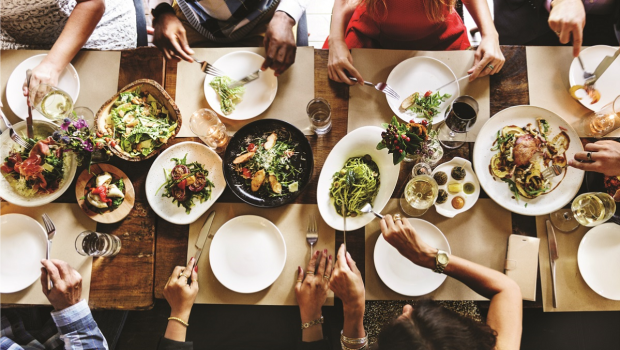The World’s Healthiest Cuisines
What Five Countries Can Teach us about Good Eating
by Judith Fertig
Americans love to explore ethnic cuisines and then put their own “more is better” spin on them, like a Chinese stir-fry turned into chop suey with fried rice or a pasta side dish supersized into a whole meal.
“We’ve Americanized dishes to the extent that they don’t have their original health benefits,” says Dr. Daphne Miller, a family physician in the San Francisco Bay area and author of The Jungle Effect: The Healthiest Diets from Around the World—Why They Work and How to Make Them Work for You.
Here are five popular—and healthy— world cuisines, known for their great dishes, star ingredients and health-enhancing practices.
Traditional Japanese
Ingredients. The dietary benefits of green tea, fermented soy and mushrooms like shiitake and maitake are well documented. Add dried seaweed to this list. Beyond sushi, it’s a delicious ingredient in brothy soups, where it reconstitutes to add a noodle-like quality, slightly smoky flavor and beneficial minerals, including calcium, copper, iron, magnesium, manganese, molybdenum, phosphorus, potassium, selenium, vanadium and zinc.
A study in the Asia Pacific Journal of Clinical Nutrition linked the longevity of Okinawan residents to eating seaweed, a staple of macrobiotic diets. New York City culinary instructor and cookbook author Hiroko Shimbo prefers dried wakame seaweed, readily available in the U.S.
Practices. Shimbo grew up in Tokyo, Japan, where her mother helped her surgeon father’s patients by preparing foods that helped them recover quickly. Shimbo believes wholeheartedly in Ishoku-dogen, a Japanese concept often translated as, “Food is medicine.”
Shimbo says, “I eat fairly well, treating food as blessings from nature that keep me healthy and energetic. I do not often indulge in expensive, rich foods.” She prefers eating foods in season and small portions, listening to what her body craves. When feeling the need for minerals and vitamins, she makes a brothy soup with just a little dried wakame, which reconstitutes to four times its dried volume.
A second practice supporting healthy well-being is hara hachi bu, or “Eat until your stomach is 80 percent full.” It requires self-discipline to eat slowly and decline more food. But this restraint supports a widely accepted fact that “It takes about 20 minutes for the brain to receive the message that the stomach is full. If we eat slowly, we get the message at the right time, even if we want a few more bites. If we eat too quickly, by the time our brain sends the message, we have probably eaten too much,” says Shimbo.
One Great Dish: Japanese soups offer nutrition and flavor in a bowl. Shimbo’s Eata-Lot Wakame Sea Vegetable Soup in her cookbook The Japanese Kitchen: 250 Recipes in a Traditional Spirit can be made with chicken or vegetable broth. Other healthy ingredients like sesame oil, fresh ginger, scallions and garlic boost its health benefits.
South Indian
Ingredients. South India—including the states of Andhra Pradesh, Karnataka, Kerala, Tamil Nadu and Telangana—offers many plant-based dishes that feature coconut, rice and spices such as turmeric, known for decreasing inflammation, according to the Journal of Alternative and Complementary Medicine. Varieties of dried split peas called dal [dal is singular and plural] are used in vegetable curries and ground to make the gluten-free savory crepes known as dosa or puffy white idlis for a snack or breakfast.
South India native and current Minneapolis resident Raghavan Iyer, teacher, consultant and author of many cookbooks, including 660 Curries, says, “One technique that gives vegetable dishes a lift is dry-frying or toasting whole spices. It adds complexity and nuttiness.” Simply heat a cast iron skillet, add the whole spices and dry fry until spicy aromas arise; then add them to a dish.
Practice. South Indian meals usually comprise many small, highly flavored, colorful, plant-based dishes served with rice. They yield a pleasant aroma and sensation of fullness without overdoing it, says Iyer.
One Great Dish: A vegetable/legume curry such as tamata chana dal, or smoky yellow split peas is simple to make. Iyer cooks dried, yellow, split peas with potatoes and turmeric, then dry-fries dried chilis and spices, and purées them in a blender for a no-fat, vegan and glutenfree dish. In Iyer’s view, “The epitome of comfort food is a bowl of dal and rice.”
Garden-to-Table Italian
Ingredients. There’s American-Italian, as in pizza with pepperoni and double cheese, and then there’s real Italian dishes dating back to the Etruscans. Healthy Italian starts with the love of growing things. Whatever grows in the garden is best, served simply with extra virgin olive oil; a recent Temple University study found it preserves memory and wards off Alzheimer’s.
Eugenia Giobbi Bone, co-author of Italian Family Dining: Recipes, Menus, and Memories of Meals with a Great American Food Family, says, “My palate was formed with the flavors of homegrown foods. Cooking in central Italy is all about bringing out the flavor of a few very fresh, well-grown ingredients. That means primarily seasonal eating, with lots of vegetables and little meat in summer, the opposite in winter. There isn’t a lot of fuss to the culinary style, which instead depends on interesting, but simple combinations of foods and techniques.”
Practice. Italian families’ view of healthful garden-to-table includes the exercise attained from gardening. “We have a good work ethic in our family,” remarks Bone, who lives in New York City and Crawford, Colorado. “We are of the mentality that physical work is satisfying, even when it is hard.”
From her father’s family, Bone has learned to break a meal into small courses and to eat heavier during the day and lighter at night because this helps maintain a healthy weight, according to many studies including one published in the UK journal Diabetologia.
One Great Dish: Dress up pasta with a seasonal vegetable sauce, such as caponata, an eggplant and tomato mixture, or include primavera via spring vegetables and basil, or arrabbiata, featuring tomatoes and red pepper flakes.
Lebanese
Ingredients. “So much about Lebanese cuisine is ‘on trend’ with our tart and sour flavors from lemon, sumac and pomegranate molasses, a wide array of vegetarian and vegan dishes, plus a tradition of pickling, called mouneh, and yogurt and cheese making,” says food blogger Maureen Abood, author of Rose Water & Orange Blossoms: Fresh and Classic Recipes from My Lebanese Kitchen.
“Lebanese cuisine is extraordinarily healthy, fitting squarely into the Mediterranean diet.” Abood lives in East Lansing, Michigan, where she loves to use summer cherries and berries in her Lebanese-inspired dishes. According to Abood, another reason why Lebanese food is so popular is that Lebanese immigrants to the U.S. now outnumber the native population of their mother country.
Practice. Gathering to share food is a hallmark of Lebanese hospitality. “The Lebanese style of eating includes maza; many small shared plates of remarkable variety,” says Abood. “Food as medicine” is also a Lebanese practice, according to a study in the journal Evidence-Based Complementary and Alternative Medicine.
One Great Dish: “Many of my favorite Lebanese dishes are plant-based,” says Abood. “We love to stuff everything from cabbage to summer squash to grape leaves with vegetarian fillings, and cook them in a garlic or tomato broth. Every week, we make and eat mujaddara, a lentil and rice or bulgur pilaf with deeply caramelized onions.” Pair with any Lebanese salad, such as one she makes with sweet cherries and walnuts for “a perfectly healthy and crazy-delicious meal.”
Vietnamese
Ingredients. Vietnamese cooking emphasizes fresh herbs and leafy greens, green papaya, seafood, rice and condiments. A study in the British Journal of Nutrition found that green or unripe papaya contains more healthy carotenoids (lutein, beta-carotene and lycopene) than tomatoes or carrots.
Practice. The preferred style of Vietnamese cooking is steaming or simmering, using less fat. It also encourages communal eating, with each diner dipping an ingredient into a cooking pot. Cooked foods are accompanied by fresh salad greens, including herbs served as whole leaves.
 One Great Dish: Vietnamese hot pot is a favorite of Andrea Nguyen, whose Vietnamese family immigrated to California. Nguyen, author of Into the Vietnamese Kitchen: Treasured Foodways, Modern Flavors, blogs about food at VietWorldKitchen.com and now lives near San Francisco, California. “This is a slow, cook-it-yourself kind of meal. Set it up, relax with some organic wine or beer and enjoy. Flavors develop and the hot pot transforms as you eat,” she says. “At the end, you’ll slurp up the remaining broth and noodles.” See Tinyurl.com/Viet-ChineseHotPotRecipe.
One Great Dish: Vietnamese hot pot is a favorite of Andrea Nguyen, whose Vietnamese family immigrated to California. Nguyen, author of Into the Vietnamese Kitchen: Treasured Foodways, Modern Flavors, blogs about food at VietWorldKitchen.com and now lives near San Francisco, California. “This is a slow, cook-it-yourself kind of meal. Set it up, relax with some organic wine or beer and enjoy. Flavors develop and the hot pot transforms as you eat,” she says. “At the end, you’ll slurp up the remaining broth and noodles.” See Tinyurl.com/Viet-ChineseHotPotRecipe.
French Bonus: While croissants and triple-crème brie might not seem part of an ideal diet, rediscover two healthy practices from the French: Eat less and eat together. Ongoing studies at Cornell University show that we eat less if offered less. When researcher Paul Rozin, Ph.D., a psychology professor with the University of Pennsylvania, compared portions in Paris, France, and Philadelphia, Pennsylvania, the Philly portions were 25 percent larger. It’s also reflected in the two countries’ cookbook recipes.
Rozin further found that French diners spent more time eating those smaller portions—perhaps explaining the French paradox: Most French eat rich foods and drink wine, yet don’t get fat.
Judith Fertig writes award-winning cookbooks plus foodie fiction from Overland Park, KS (JudithFertig.com).
Images: Rawpixel.com/Shutterstock.com , VICUSCHKA/Shutterstock.com




























